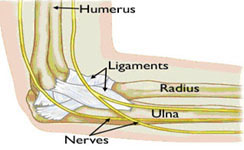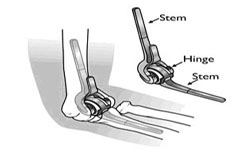








Although elbow joint replacement is much less common than knee or hip replacement, it is just as successful in relieving joint pain and returning people to activities they enjoy.
The elbow is a hinge joint which is made up of three bones:
The humerus (upper arm bone)
The ulna (forearm bone on the little finger side)
The radius (forearm bone on the thumb side)
The surfaces of the bones where they meet to form the elbow joint are covered with articular cartilage, a smooth substance that protects the bones and enables them to move easily. A thin, smooth tissue called synovial membrane covers all remaining surfaces inside the elbow joint. In a healthy elbow, this membrane makes a small amount of fluid that lubricates the cartilage and eliminates almost any friction as you bend and rotate your arm. Muscles, ligaments, and tendons hold the elbow joint together.
The people with damaged knee with severe pain which limits day to day activities and development of deformities like inward or outward bending of legs, indicates the need of knee replacement. The following are the most severe causes of joint replacement:
In total elbow replacement surgery, the damaged parts of the humerus and ulna are replaced with artificial components. The artificial elbow joint is made up of a metal and plastic hinge with two metal stems. The stems fit inside the hollow part of the bone called the canal.
Several conditions can cause elbow pain and disability, and lead patients and their orthopaedic surgeons to consider elbow joint replacement surgery.
This is a disease in which the synovial membrane that surrounds the joint becomes inflamed and thickened. This chronic inflammation can damage the cartilage and eventually cause cartilage loss, pain, and stiffness. Rheumatoid arthritis is the most common form of a group of disorders termed "inflammatory arthritis."
Osteoarthritis is an age-related, "wear and tear" type of arthritis. It usually occurs in people 50 years of age and older, but may occur in younger people, too. The cartilage that cushions the bones of the elbow softens and wears away. The bones then rub against one another. Over time, the elbow joint becomes stiff and painful.
This type of arthritis can follow a serious elbow injury. Fractures of the bones that make up the elbow, or tears of the surrounding tendons and ligaments may cause damage to the articular cartilage over time. This causes pain and limits elbow function.
A severe fracture of one or more bones that make up the elbow is another common reason people have elbow replacements. If the elbow is shattered, it may be very difficult for a doctor to put the pieces of bone back in place. In addition, the blood supply to the bone pieces can be interrupted. In this type of case, a surgeon may recommend an elbow replacement. Older patients with osteoporosis (fragile bone) are most at risk for severe elbow fractures. In addition, some fractures do not heal well and may require an elbow replacement to address continuing probably.
Making simple changes in your home before surgery can make your recovery period easier. For the first several weeks after your surgery, it will be hard to reach high shelves and cupboards. Before your surgery, be sure to go through your home and place any items you may need afterwards on low shelves.
To reach the elbow joint, your surgeon will make an incision (cut), usually at the back of the elbow. After making the incision, your surgeon will gently move muscles aside to get access to the bone. After removing scar tissue and spurs around the joint, your surgeon will prepare the humerus to fit the metallic piece that will replace that side of the joint. The same preparation is done for the ulna.The replacement stems are placed into the humerus and ulna bones, and kept in place with a bone cement. The two stems are connected by a hinge pin. After the wound is closed, a padded dressing is then placed to protect the incision while it heals. Some surgeons will place a temporary tube in the joint to drain the surgical fluid. This tube can be easily removed in your hospital room within the first few days after surgery.
A careful, well-planned rehabilitation program is critical to the success of an elbow replacement. You will be taught some exercises for your hand and wrist to avoid stiffness and help to control swelling. You will do gentle elbow range-of-motion exercises as the incision heals. Your doctor may prescribe therapy or may teach you how to do the exercises yourself. You will most likely not be allowed to put any weight on your arm or push against resistance with your hand until about 6 weeks after your surgery.
Website Designed By: Quick n Host